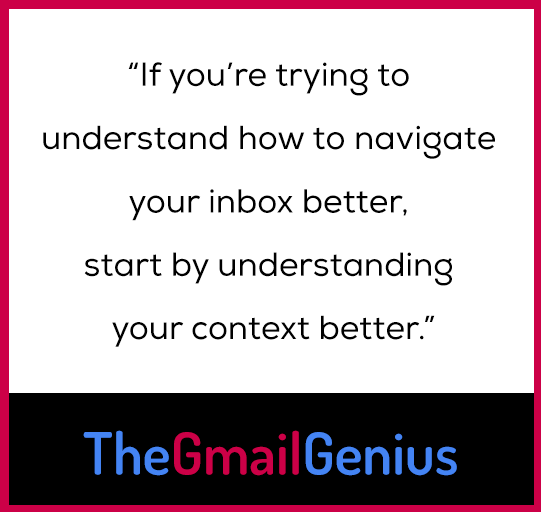How I Email: Jay Acunzo, Author, Break the Wheel
Email is a non-negotiable part of everyday life. For some, it’s an unruly time suck, but enlightened email users have systems to ensure they’re not a slave to the inbox. We’re asking smart thinkers to give us a peek inside their inboxes, share tips, ideas, gripes, and everything in between.
Most people don’t have a strategy for making the best decisions, and that’s where Jay Acunzo comes in. In his book, “Break the Wheel” and Damn the Best Practices newsletter, Jay, who has worked for Google and HubSpot, aims to inspire you to be an original and create your own roadmap. We chatted about how to navigate your inbox in a way that works best for you.
 How do you approach email each day?
How do you approach email each day?
Right now, my obsession is to create time for deep and meaningful work. That starts with my routine before I go to sleep. I don’t sleep with the phone in the bedroom. There are no screens—no TV, no laptop, no phone. I’ve been doing this for a few months.
As a result, when I wake up in the morning, I no longer have the urge to check the phone right away. When I wake up it’s about being mindful and starting my day in a way that allows me to pursue the thing that brings me the most joy—that’s writing.
I write for one hour each morning, doing everything in my power not to check any inbox. If I start my day with writing, my day is fundamentally better. I’m not trying to avoid the dopamine hit of checking my inbox, but I’m trying to convince myself that I get an even greater dopamine hit by pursuing my joy. Basically, I’m letting my animal brain run wild.
I structure my weeks instead of my days. The days are variable, but my weeks are a bit more rigid. I reserve Mondays and Fridays for admin and office-type work. On Tuesday, Wednesday, and Thursday, I’m either on the road delivering keynotes or at home with blocks of time to do big, meaningful projects. I think we try to over-engineer every moment of our day. We should protect our calendars more and block off the time to do the actual, precious work. I don’t want a manager’s schedule. I want a maker’s schedule.
Do you have any go-to tools that help you manage email?
Nope. Not one. I think it’s far better to work on the wizard than to find a wand.
We start with the tools because it’s easier than the work of self reflecting on your own behaviors.
For example, we like talking about going to the gym, rather than actually going to the gym. So reading an article about time management for your inbox, gives you the feeling of doing something about it rather than doing the work to figure out what will work for you.
Your book is about questioning best practices and finding the best solution for your situation. How did you come to this message?
I remember my first job out of college being the moment when I found out what what’s best for others might not be best for you.
My first job out of college was at Google. I thought it was the best job I could get right out of school. I’d done everything I was supposed to until that point and had succeeded in getting my dream job. But I hated the job, and I wasn’t prepared to hate the job you were supposed to love.
Eventually I left. I had some friends who stayed and they really liked it— another thing I wasn’t prepared to deal with. It was right for them, but it wasn’t the right fit for me. It made me realize that if you embrace that there is no one right way, you open yourself to infinite possibilities. But that’s harder to navigate. School doesn’t prepare us for that because we’re taught that there are right and wrong answers. So how do you make the best possible decision when all of a sudden, the clarity that comes with having a right and wrong answer goes away? That’s what the book is about.
 If best practices isn’t the way to go, how should people think about inbox management?
If best practices isn’t the way to go, how should people think about inbox management?
Some people cling to Inbox Zero, others don’t. The point isn’t to say that Inbox Zero is absolutely good or bad. The point is to understand if any idea or approach is right for you, wrong for you, or somewhere in the middle. In the book, I talk about setting up your “instant clarity generator” to develop self-awareness and situational awareness. This is a series of questions you can ask of any given situation (for instance, vetting ideas for improving your inbox or lowering your email stress) in order to make the best possible decision for you — regardless of the trend or best practice. That’s what really matters, in the end.
If you look at any situation you face at work, there are three elements to understand to find clarity:
1- You (the person or team doing the work). Do you understand what you aspire to do? That’s your first filter against advice overload.
2- Your audience (the person or people the work is for, like a customer or reader or even a boss or client you’re pitching). Do you understand a fundamental, “first-principle insight” about them to inform your decisions?
3- Your resources (the means to make the work happen). Do you understand your constraints? Studies show that knowing constraints up front helps improve creative problem-solving.
So for instance, for my work: I aspire to be the Anthony Bourdain of business. That means I shouldn’t spend much time trying to be better at email. I should invest heavily in my storytelling abilities. The only way I know that Inbox Zero is a worthless pursuit is because I answered #1 from above. Likewise, me telling you that checking email once per day could indeed be good advice — but it can also be terrible advice, depending on your reality. For instance, maybe you work in a field where customers need instant replies. The only way to make this decision is to know #2 from before, know your audience. Lastly, if you don’t understand your resources (#3), then the alternative is to thrash or get frustrated. You either want creative freedom or keep running into invisible walls created in the moment by clients or bosses.
So, if you want to know how to handle email better, start by understanding your context better: What you’re trying to achieve in your work, what others expect or want from you in reality (you may think it’s a reply; maybe it’s actually results from your work, which means putting off the reply they think they want); and the resource constraints that make up your reality. Understand yourself and your situation first, and you can then funnel all advice through that instant clarity generator.
What are your email pet peeves?
When somebody asks you to meet or set up a call and then they make you do the work to schedule it! Like when they send a scheduling a link, so that I can go look at their availability, compare it with mine and then make the appointment. You invited me, you asked to get on my calendar, which means you have to be the concierge. You need to make sure the person you invited is having a good experience. Calendly is not that. Fuck Calendly. Calendly makes total sense when making a meeting with coworkers. But it’s not for a networking meeting.